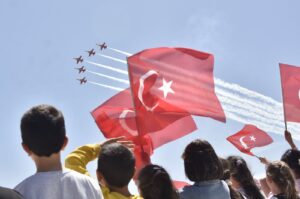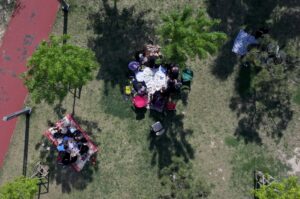Several monumental stone heads located in Mount Nemrut and other UNESCO-listed statues in southeastern Türkiye have survived despite the powerful earthquakes that struck the region last month, according to Turkish authorities.
Footage captured by Anadolu Agency (AA) showed the massive heads, each weighing tonnes, on the eastern face of the mountain in Adiyaman province.
Irfan Cetinkaya, head of a culture and tourism association in the province’s district of Kahta, where Mount Nemrut is located, noted that the earthquake caused severe damage in the region.
“The only thing that makes us happy is that the statues on Mount Nemrut were not affected by the tremors. I went to Mount Nemrut two days after the quake, and saw that the statues were not damaged even though Adiyaman suffered a great disaster,” Cetinkaya said.
Nemrut has been a UNESCO World Heritage Site since 1987. It is a 2,134-meter-high mountain featuring giant 10-meter high, seated statues of King Antiochus I and surrounded by ancient gods, including Zeus and Apollo.
The statues were believed to have been erected during the 1st century BC.
Before the earthquake, hundreds of thousands of people come to the region every year.
As the country begins its period of recovery, Centinkaya invited visitors to return and visit the site.
“Especially this year, we want more people to visit Mount Nemrut. We want them to come to the region to give us morale, to heal our wounds, as well as to see Mount Nemrut.”
READ MORE: Türkiye continues to heal from wounds inflicted by twin quakes one month on
Open Air Museum Survived
Meanwhile, artifacts in the Yesemek Open Air Museum and Sculpture Workshop, an archaeological site in the southern Gaziantep, also survived the February 6 tremors unscathed, despite widespread damage in the province.
The historical area is included on the UNESCO World Cultural Heritage Tentative List. It is located in the town of Yesemek in Islahiye district, home to artifacts from the early Hittite civilization, which existed in the 13th century BC, with stone statues weighing up to 10 tonnes.
“I was curious about the state of the museum after the earthquake as they (tremors) were so severe. I went to the museum. There was no destruction here, all the artifacts were still standing,” Museum officer Ali Cicek told AA.
More than 46,100 people have been killed in the back-to-back earthquakes that struck Türkiye on February 6.
The magnitude 7.7 and 7.6 quakes hit at least 11 provinces.
More than 13.5 million people in Türkiye have been affected by the devastating quakes, as well as many others in northwestern Syria, where over 5,000 were also killed.
READ MORE:
‘Antakya has fallen six times’: Türkiye antiques seller vows to stay put




















































Be First to Comment